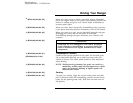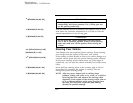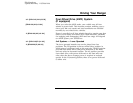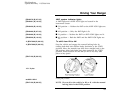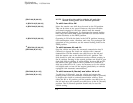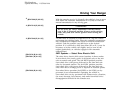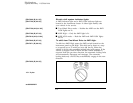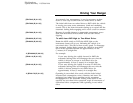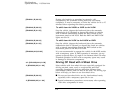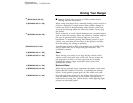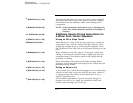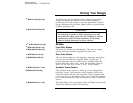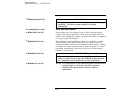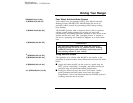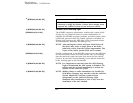
Driving Your Ranger
173
[DR17945(R )01/95]
At extremely low temperatures, it may be necessary to slow
down or even stop to shift from two wheel drive to 4WD.
[DR17960(R )01/95]
The initial shift from two-wheel drive to 4WD while the vehicle
is moving can cause some momentary clunk and ratcheting
sounds. This is the front drivetrain coming up to speed and the
automatic locking hubs engaging and is not a cause for concern.
[DR17990(R )01/95]
Because of possible damage to powertrain components, never
shift from two-wheel drive to 4WD with the rear wheels
slipping.
[DR18020(R )07/94]
To shift from 4WD High to Two-Wheel Drive:
[DR18050(R )03/95]
Rotate the 4WD switch to 2WD; the 4WD light on the
instrument cluster will go out, indicating the vehicle is in
two-wheel drive. This can be done at any speed. To disengage
the automatic locking hubs, operate the vehicle in two-wheel
drive in the opposite direction for approximately 10 feet
(3 meters) in a straight line.
*
[DR18080(R )06/94]
For example:
[DR18110(R )01/95] If you were driving the vehicle forward in 4WD the
automatic locking hubs will disengage the next time the
vehicle is driven in reverse in two-wheel drive for
approximatedly 10 feet (3 meters) in a straight line.
[DR18140(R )01/95] If you were driving the vehicle in reverse in 4WD, the
automatic locking hubs will disengage the next time the
vehicle is driven forward in two-wheel drive for
approximately 10 feet (3 meters) in a straight line.
*
[DR18170(R )01/95]
Operating in two-wheel drive mode with the hubs locked
increases fuel consumption, noise, vibration, and wear. For
prolonged two-wheel drive operation on dry pavement,
disengagement of the automatic locking hubs, which is not
required for two-wheel drive operation, stops all movement of
front-wheel drive components while operating in two-wheel
drive.
File:10undrr.ex
Update:Wed May 1 13:52:06 1996



